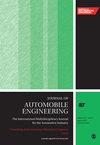为非耦合共享转向设计具有人机交互功能的方向盘扭矩
IF 1.5
4区 工程技术
Q3 ENGINEERING, MECHANICAL
Proceedings of the Institution of Mechanical Engineers Part D-Journal of Automobile Engineering
Pub Date : 2024-04-22
DOI:10.1177/09544070241246578
引用次数: 0
摘要
在基于线控转向(SBW)系统的非耦合共享转向架构中,驾驶员无法直接获取路感和自动化相关信息。为解决这一问题,本文提出了一种考虑人机交互信息的方向盘扭矩反馈模型。首先,在自动化车辆横向控制中采用了模型预测控制(MPC)。然后,应用基于模糊控制的控制权分配模型,根据路径侧向危险(PLH)因子和驾驶员意图评估(DIE)因子的值,在人类驾驶员和自动驾驶系统之间分配控制权权重。这两个因素分别反映了车辆横向碰撞的概率和驾驶员驾驶意图的强度。其次,在方向盘反馈力矩模型中加入了路感反馈力矩和人机界面(HMI)反馈力矩,以增强驾驶员对 SBW 车辆的体验和对自动驾驶系统的信任。人机界面反馈扭矩旨在为人类驾驶员提供有关控制权重量变化以及人类驾驶员与自动化系统之间期望角度偏差的信息。仿真和实验结果表明,所提出的非耦合共享控制方法可加快驾驶员对自动化的接受程度,并为驾驶员提供更直观的转向体验。本文章由计算机程序翻译,如有差异,请以英文原文为准。
Design of steering wheel torque with human-machine interaction for uncoupled shared steering
In the uncoupled shared steering architecture based on the steering-by-wire (SBW) system, direct access to road feel and automation-related information is unavailable to the driver. To address this problem, this paper proposes a steering wheel torque feedback model that considers human-machine interaction information. First, the model predictive control (MPC) is adopted in lateral vehicle control by automation. Then a fuzzy control-based control authority allocation model is applied to assign the control authority weight between the human driver and automation according to the value of the Path Lateral Hazard (PLH) Factor and the Driver’s Intent Evaluation (DIE) Factor. These two factors reflect the probability of lateral vehicle collision and the intensity of the driver’s driving intention, respectively. Next, the road feel feedback torque and the human-machine interface (HMI) feedback torque is incorporated in the steering wheel feedback torque model to enhance the driver’s experience in SBW vehicles and trust in the automation. The HMI feedback torque is designed to provide human drivers with information on control authority weight variation and desired angle deviation between the human driver and automation. Simulation and experiment results suggest that the proposed uncouple shared control method can accelerate driver acceptance of automation and provide the driver with a more intuitive steering experience.
求助全文
通过发布文献求助,成功后即可免费获取论文全文。
去求助
来源期刊

CiteScore
4.40
自引率
17.60%
发文量
263
审稿时长
3.5 months
期刊介绍:
The Journal of Automobile Engineering is an established, high quality multi-disciplinary journal which publishes the very best peer-reviewed science and engineering in the field.
 求助内容:
求助内容: 应助结果提醒方式:
应助结果提醒方式:


